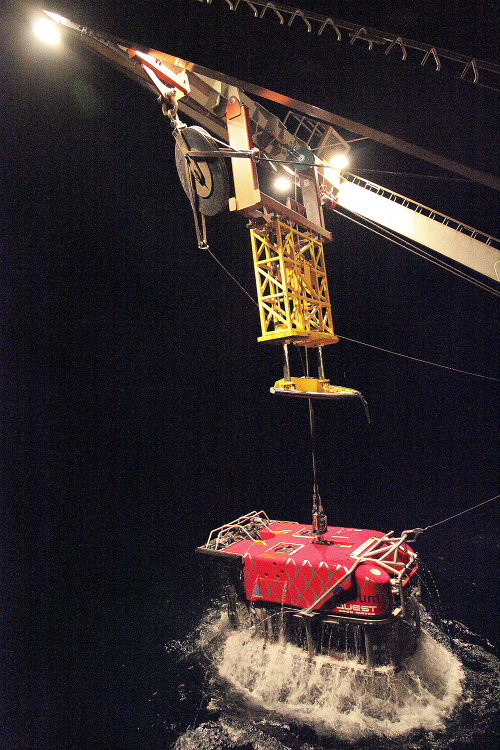
By Joe Resing, Senior Research Scientist - JISAO University of Washington, NOAA PMEL
September 26, 2012
2035 GMT
Wind – E @ 7.2 kts
Air Temperature – 28.3° C (82.9° F)
Sea State – 0.5m

The ROV Quest 4000 rises out of the water on its last dive of the Submarine Ring of Fire Northeast Lau Basin 2012 Expedition. Image courtesy Richard Arculus, (Research School of Earth Sciences, Australian National University). Download larger version (jpg, 19.4 MB).
So far we have seen some stunning sites. The Lau Basin, in particular its NE portion, is one of the most volcanically- and hydrothermally- active places on Earth. Our planet still holds many amazing phenomena that remain to be visited, discovered and understood. In particular, the deep ocean is hidden from view, and its unexplored places remain a major challenge to humankind. We have done a lot of “homework“ in preparation for this trip. It is a rare opportunity to get a deep ocean robot to conduct operations like this in these distant parts of the world ocean and preparation is everything to a successful mission. We found hydrothermal activity at almost every dive site because we used our advanced reconnaissance coupled with information gathered from our colleagues around the world to make the most of this very rare opportunity to explore this area of our ocean.

Submarine Ring of Fire Northeast Lau Basin 2012 Expedition Team on the bow of the R/V Roger Revelle shortly after pulling into Samoa, at the conclusion of the expedition. Image courtesy of Submarine Ring of Fire 2012: Northeast Lau Basin, NOAA-OER. Download larger version (jpg, 2.1 MB).
As we pulled the Quest 4000 from the water for the last time, a great sense of pride welled up in me. What a fantastic mission we have had. What we saw over a mile deep on the ocean floor was stunning. What we learned generated a craving in each of us to learn more, to discover more and to better understand the planet on which we live. However, understanding our home, understanding the vast reaches of our habitable – and inhabitable - planet takes a lot of work, a lot of coordination, and a lot of infrastructure. This R/V Roger Revelle, its crew, and the science technicians are part of the Scripps Institute of Oceanography , and the ship belongs to the U.S. university fleet of research vessels. The deep ocean robotic vehicle is owned and operated by MARUM at the University of Bremen in Germany. The scientists, meanwhile, are from multiple institutions across the U.S. and around the world. At the heart of this project is the NOAA Pacific Marine Environmental Laboratory which houses and nurtures a team of experts who understand the deep inner ocean and the ecosystems that it hosts, especially those surrounding submarine volcanoes. Finally, of course, the Office of Ocean Exploration and Research at NOAA makes it possible to explore Earth’s largest habitat. I must confess that this trip made me truly appreciate the hard work that makes the efforts of the NOAA Vents program possible.